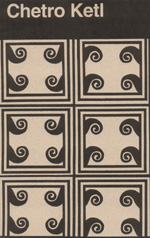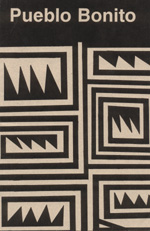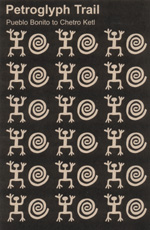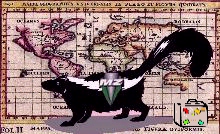
The park's layout |

The view went on forever |

Hungo-Pavi ruins |
| |
|
Mom and Dad drove from Dallas and met Ronna, Mark, and me at the Albuquerque airport on Thursday morning. We had lunch, picked up some Doubleshots,
and drove to Chaco Culture National Historic Park. Chaco is also a World Heritage Site, which offers it much more protection and funding. The road into the park is not
paved and we all had fun helping Ronna navigate the washboard dirt. We were in a but of a hurry because you cannot reserve campsites in the campground there and it's
not a very big campground in the first place. But we arrived in plenty of time and secured a fantastic spot near the back of a box canyon, with high rock walls all around us.
|
|
Chaco is a fascinating place, with ruins dating back to 800 A.D. It was apparently a large cultural and trading center for the ancient peoples of South and North America.
The Chaco road stretches south to Mexico's Casas Grandes sites and north as far as Utah, with spokes reaching in all directions. There are many ruins of big
buildings commonly referred to as "great houses" in the area, some of which had 800+ rooms spanning 5 stories! The masonry of these buildings is truly awe-inspiring,
with razor-sharp 90-degree corners and tightly fitted rock walls needing very little mortar to keep them standing.
|
| |
|
Chaco's history is mostly lost, despite oral traditions of the Pueblo tribes. In most cases, and despite excavation, it's not even known why the great-houses
were constructed. The theory that this was a trading center is supported by the findings in the rooms, but there are still mysteries everywhere. Some of the rooms
appear uninhabtable, without fresh air or even a door into them! They were apparently built to be empty! Why? The question plagued me during my visit to Chaco.
I just couldn't reconcile the intense work that went into these sites with the fact that they fell into disuse around 1100 A.D. Why work so hard to build something so
precise and sturdy only to walk away from it? It boggled my mind. And why is there no cultural "memory" or record of these compounds that took hundreds of
years to assemble? Surely each of the Pueblo tribes in America today must have ancestors traced back to this time period. And since there are native stories that
date back farther than 800 A.D., why is there such "radio silence" regarding this region?
|
| |
|
Did people live here? Or were these just prehistoric bed-and-breakfasts? Why all the kivas? They're mostly the same, just of varying sizes. Were different
clans assigned to different kivas? What, exactly, went on in there that the roofs were all deliberately ruined when the site was vacated? I think that many of
these questions actually have answers among the living Natives today; but for some reason they choose to remain quiet. If it's sacred, then silence is
their religious perogative, but that doesn't cure me of my intense curiosity! If you go there, be sure to watch the hour-long video tape that plays at the
Visitor's Center in the auditorium. This tape discusses and illustrates the different astronomical cues by which the various great-houses were constructed.
It's very impressive and inspiring. It's also frustrating as it asks more questions than it answers.
|
| |
| I have so many pictures to share - click on the images below to see them all |
| |

Our campsite |
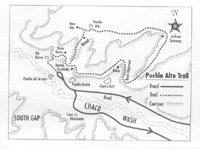
The hike up to Pueblo Alto |

The hike to Penasco Blanco |






